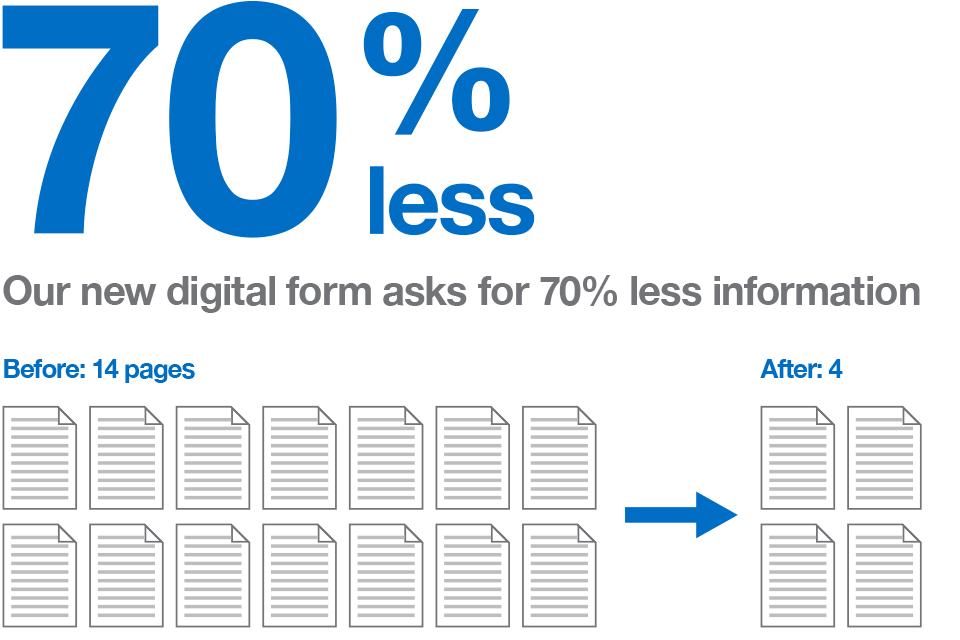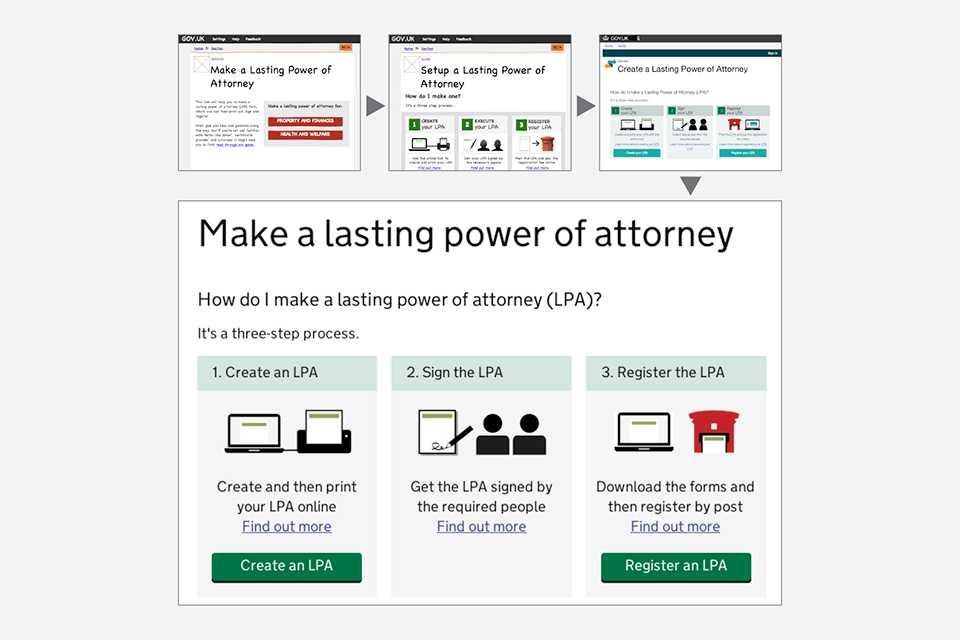Action 2 case study: redesigning services
Published 24 March 2014
Redesigning services
Video about redesigning services
Roo Reynolds (GDS), Nikki Marsh (DWP) and Carolyn Williams (DVLA) talk about redesigning services the digital way
Roo Reynolds been working on ambitious new projects to turn inefficient, outdated and entirely paper-based government services into cutting-edge digital ones.
The aim isn’t to simply digitise what was there before, but to make the new service as good as the best things people are already using on the internet.
That means starting with what people actually need, and iterating through lots of small changes. Roo says:
We start with the smallest, simplest thing that could possibly work, and build gradually from there.
One of these projects is for the Office of the Public Guardian. It handles the process of setting up lasting power of attorney for people who, for one reason or another, need someone else to take over the handling of their financial and legal affairs.

Our new digital form asks for 70% less information.
The only way this was possible until now was by filling in a lengthy and intimidating paper form. The majority of applicants had to get legal experts to help them fill it in, and even those experts sometimes made mistakes. Roo says:
It was a painful process at what, for many people, is a very difficult moment in life. We wanted to see if we could make it simpler and faster.
A prototype web service was built within weeks, and is now undergoing user testing.

Make a lasting power of attorney.
Another example: to support the government’s proposed change from household to individual voter registration, the new service will be digitised. The Electoral Registration Transformation Programme aims to make the whole process faster and easier and to cut down on the huge amount of paperwork currently handled by electoral services teams nationwide.
Crucial to both of these projects - and many more to come - is the approach the team is using while building them.
You get early feedback from all the people whose opinions can help you change what you’re building.
It sounds really obvious but it’s not the way government has always worked in the past.
Roo Reynolds is a Product Manager at the Government Digital Service. Read Roo’s posts on the Government Digital Service blog.
The Government Digital Strategy sets out an ambitious programme of change across government, but some departments have already started making those changes. The key to success, they have discovered, is ensuring that new digital services are designed and run by managers who have a keen sense of connection with the people who use them - managers like Nikki Marsh and Carolyn Williams.
Nikki is head of digital services at the Department of Work and Pensions (DWP), working on new ways to distribute benefits such as Carer’s Allowance. Understanding from the outset what the people using those services really need is crucial for building good online versions, she says.
Your number one consideration is that you’re dealing with a user experience, not a process.
She describes how sometimes the organisation has inadvertently defaulted to wondering “why aren’t our customers doing what we expected or asked them to do on this new website”? Her response to that was “Why? It’s because sometimes we are asking them to do something that isn’t natural behaviour to them - or maybe because we have said it in ways that are clearly understood by departmental staff, but not by people outside”.
On the web, people just want to get the job done. Quick and simple.
The solution? To start with the natural, obvious way of doing things, and build web services that match that.
An example of a very successful web service is Electronic Vehicle Licensing (EVL), created by the Driver and Vehicle Licensing Agency (DVLA). Carolyn is their head of electronic services, and speaks with pride about EVL’s success to date. Millions of car owners use it because it’s quick and simple. It saves them time. She says:
Customers want to come in, use the service, and get out again. You have to take responsibility for that.
Carolyn is always looking for ways to make things work even better. When she discovered that thousands of people were not using EVL because the online form asked for their car’s mileage, she campaigned for that question to be removed.
It’s a simple thing, but people were stopping at that point because that question meant they had to get up from their computer and go and look inside their car.
The lesson was learned: people don’t want to be interrupted when filling out forms on the web. They want to settle down and get the job done. Quick and simple. The question was dropped. Carolyn says:
Knowing your customers is the most important thing you can do.
The work of people like Nikki and Carolyn will be critical to the success of the Government Digital Strategy in the years to come. As the digital strategy is rolled out, all departments will be making sure they have similar service managers who understand both the customers they serve and the ways digital technology can be put to use in serving them.
Despite their success to date, neither is content to stand still.
Nikki puts it simply: “It’s not always about chasing the next shiny new thing. We have to keep asking ourselves: what have we learned from what we’ve already done? How can we make things as good as they can be?”
Nikki Marsh is Head of Digital/Online Services in the Department of Work and Pensions.
Carolyn Williams is Head of Electronic Services at the DVLA.
